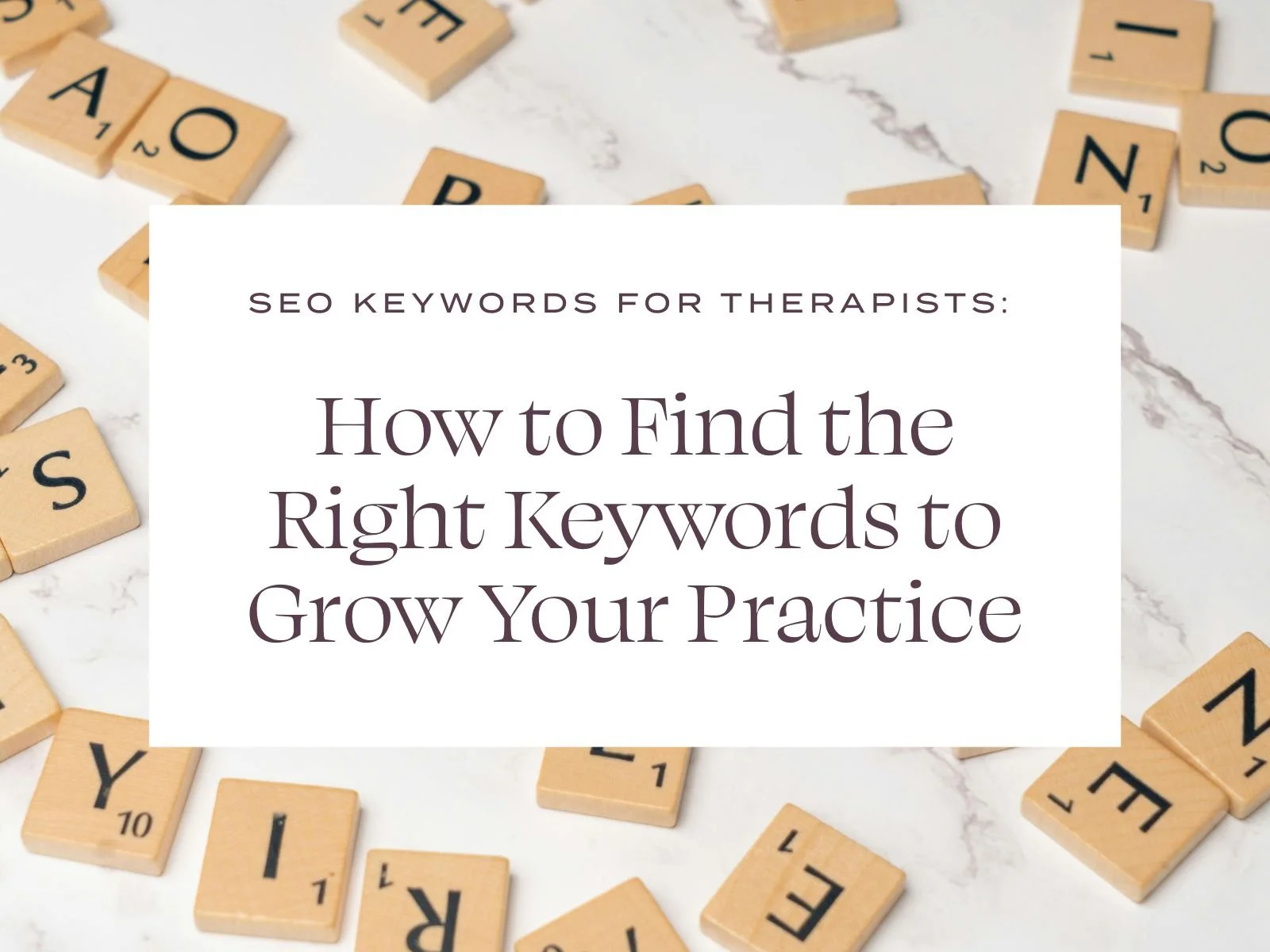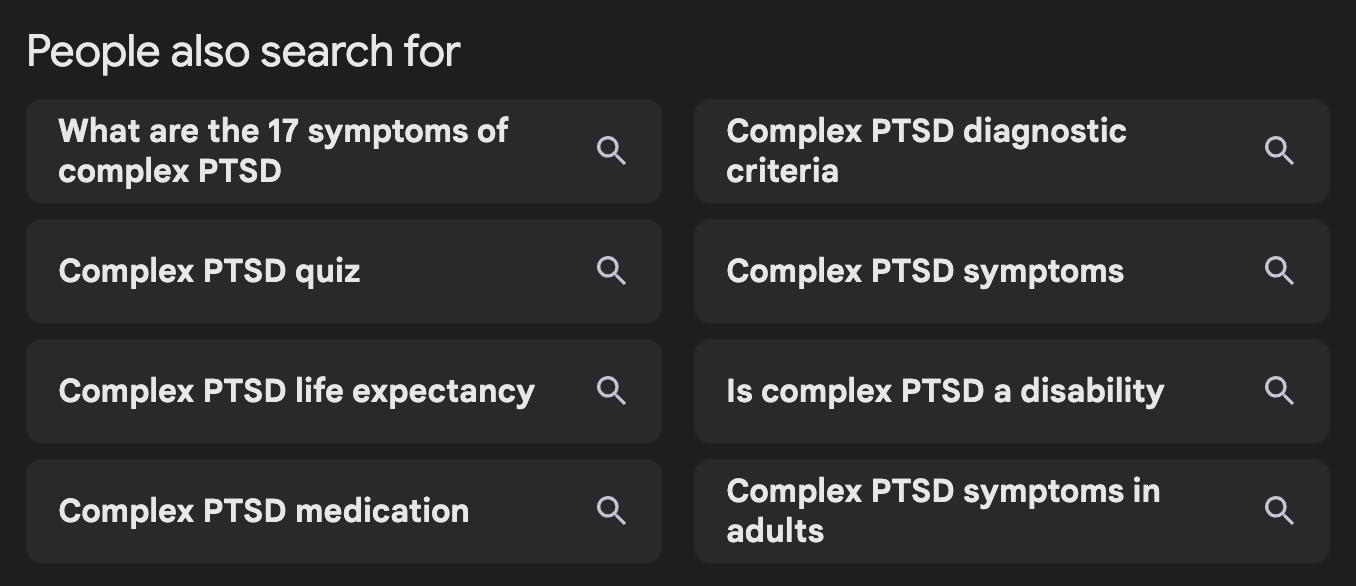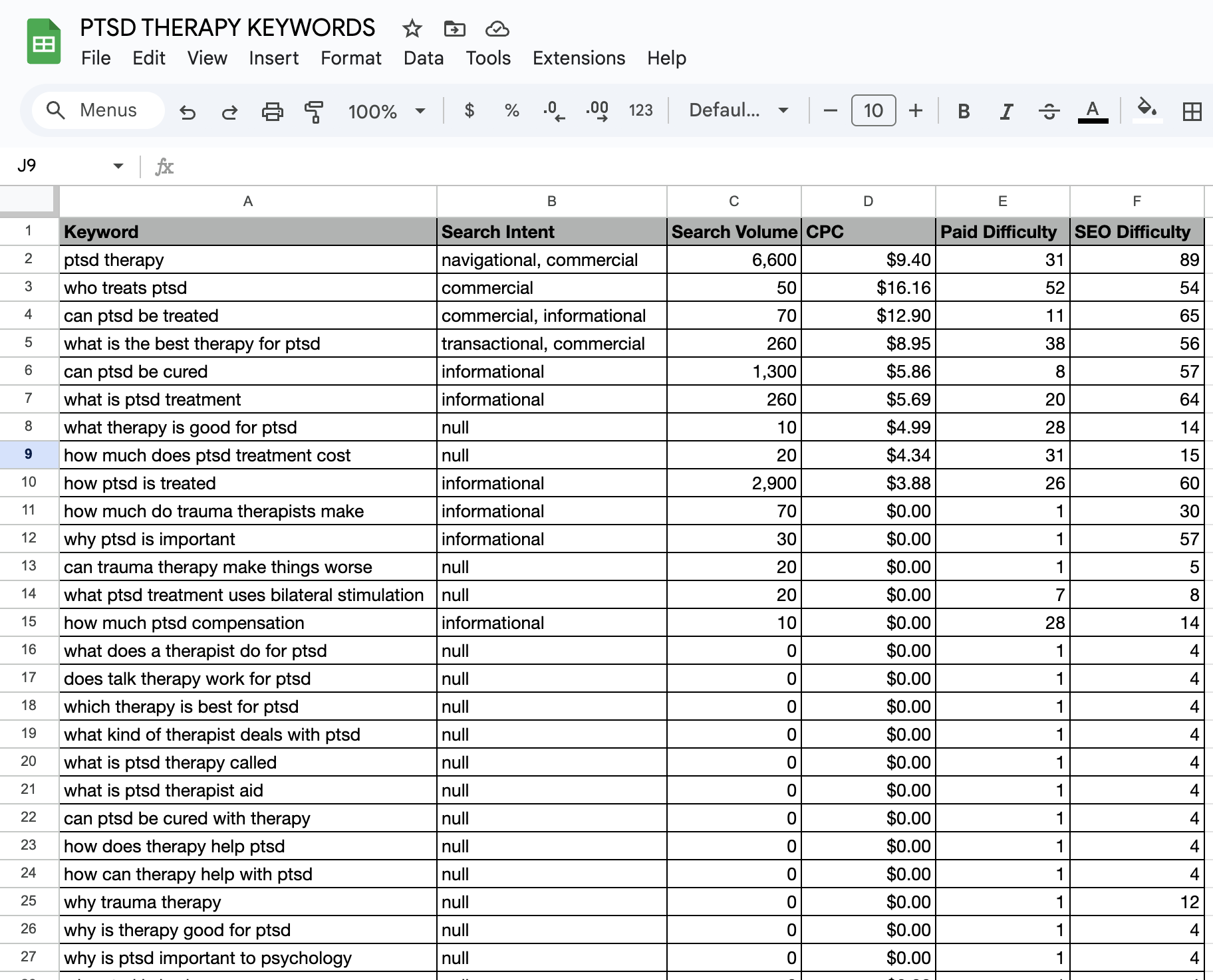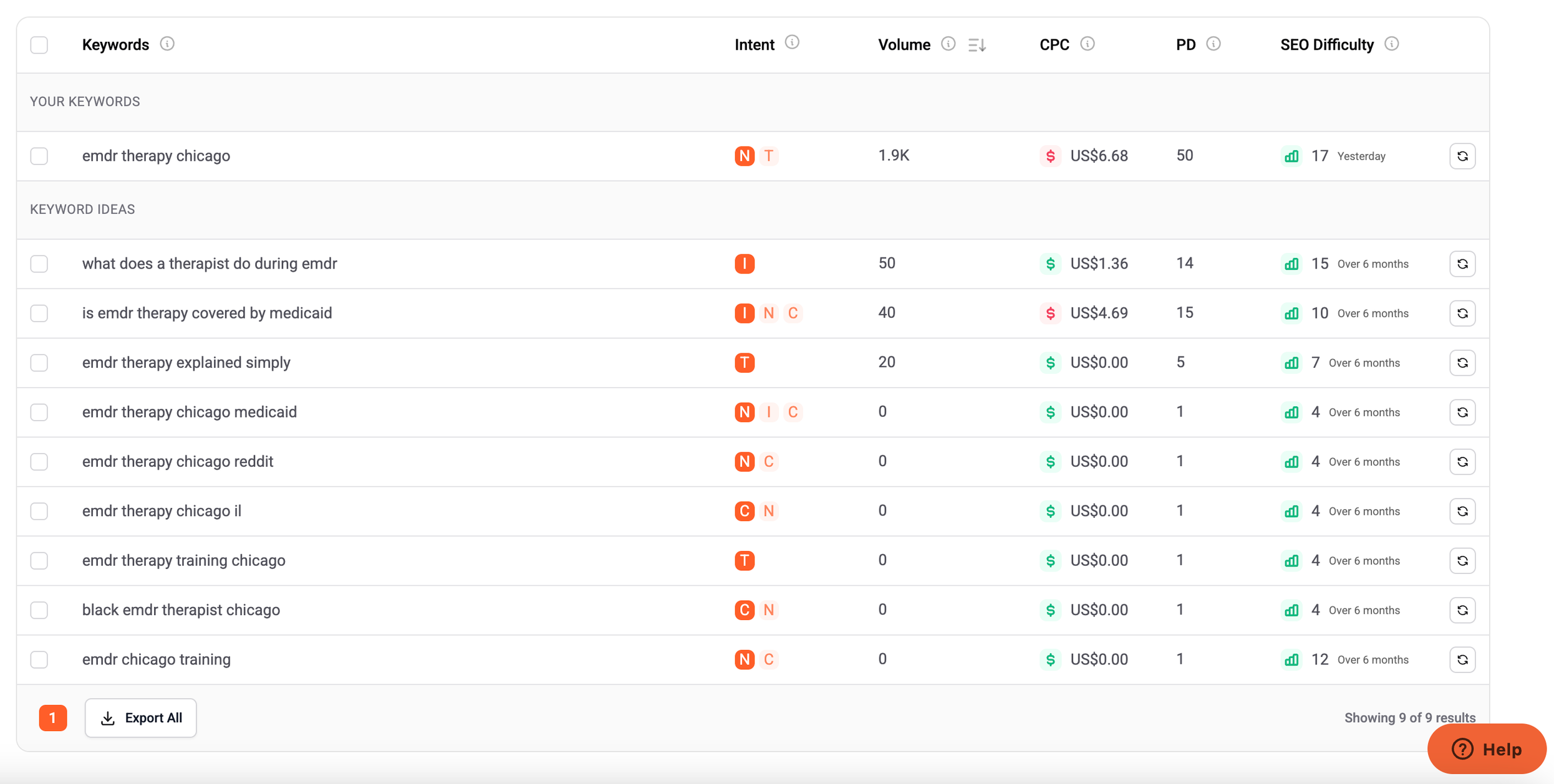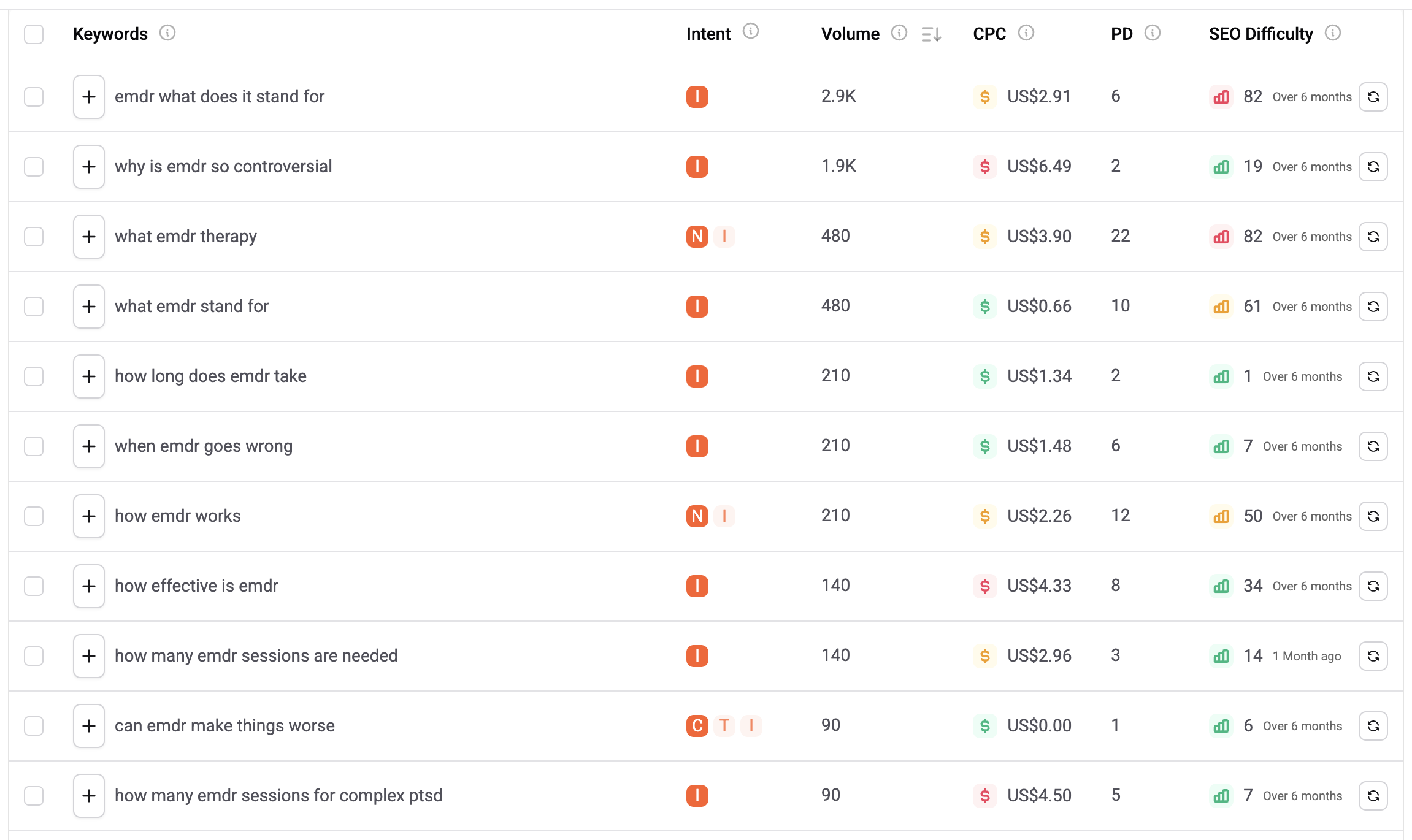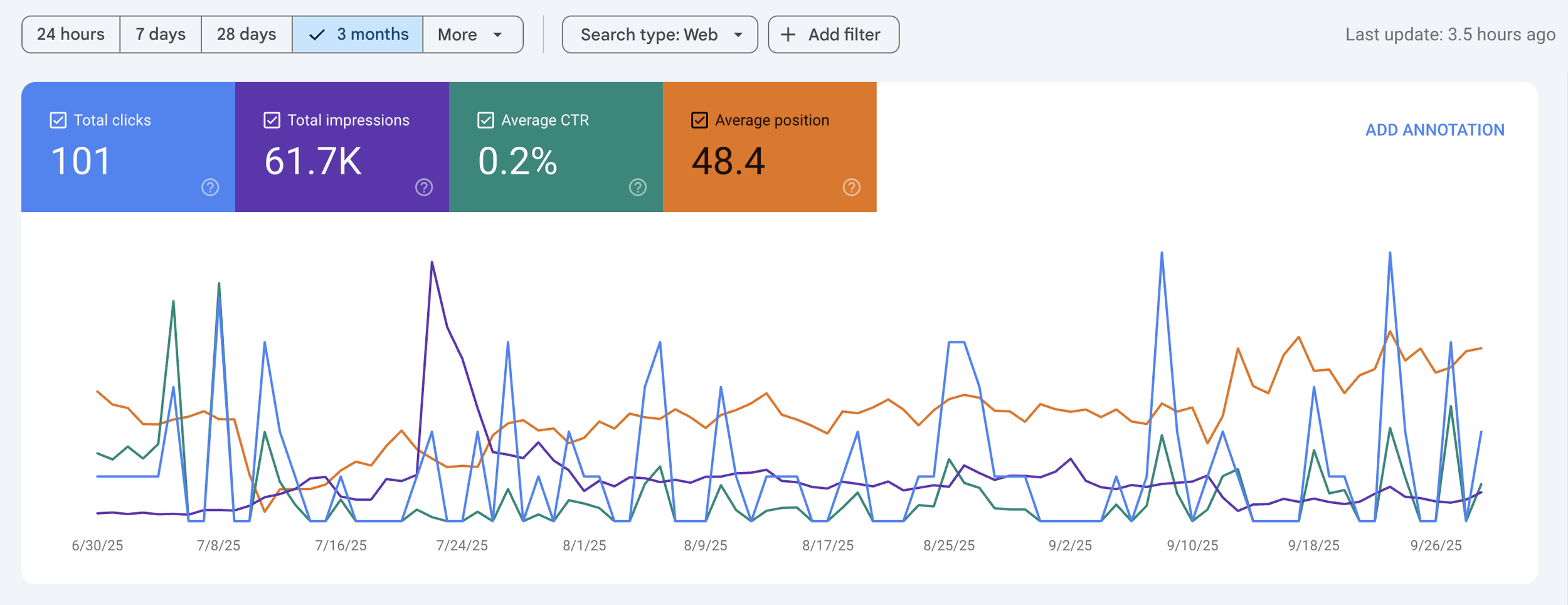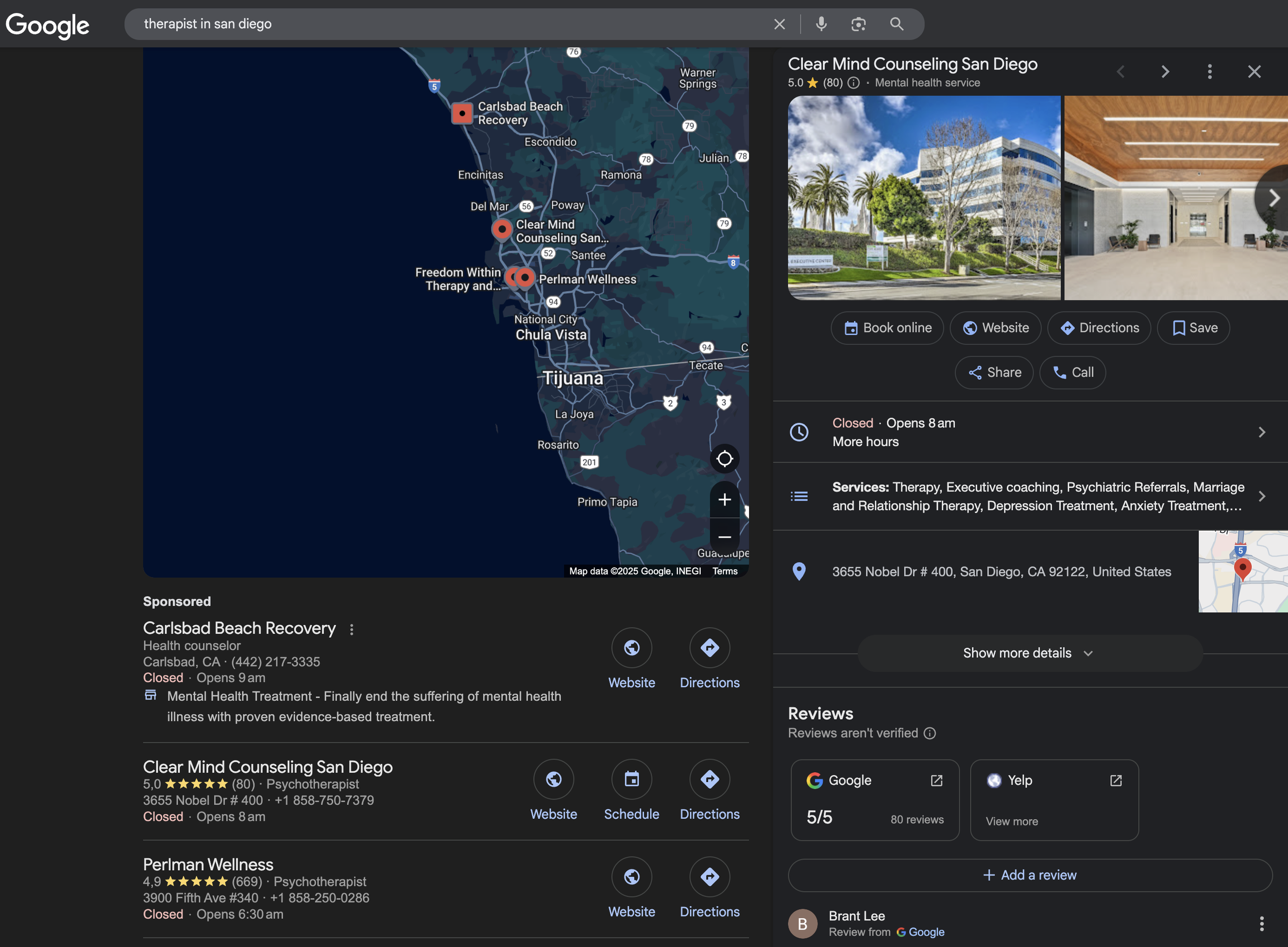SEO Keywords for Therapists: How to Find the Right Keywords to Grow Your Practice
Most therapists know they “should be doing SEO” — but few know where to start. In reality, the foundation of good SEO is simple: knowing what your ideal clients are actually typing into Google. This post breaks down how to find and use the best SEO keywords for therapists and other mental health professionals — so you can attract aligned clients, get consistent inquiries, and stop relying solely on social media.
Table of Contents
What Are SEO Keywords for Therapists?
Let’s start with the simplest truth about SEO:
Your clients are already searching for you — they just don’t know your name yet.
When someone types “how to stop overthinking,” “couples therapy near me,” or “trauma therapist online,” they’re reaching out into the digital world for help. SEO keywords are the exact words and phrases that connect those searches to your website.
In other words, keywords are the bridge between what your ideal clients are thinking and what you offer.
They help Google understand what your pages are about — and more importantly, they help the right people find you at the exact moment they’re ready for support.
For therapists, the right keywords are usually simple and intuitive.
They describe your services, your specializations, and the emotional experiences you help clients navigate.
For example:
| Keyword Type | Example | Search Intent |
|---|---|---|
| Service-based | couples therapy near me | Local — someone looking to book a therapist |
| Niche-based | trauma therapist EMDR | Transactional — specific modality or expertise |
| Emotional / client language | help for anxiety and overthinking | Informational — searching for relief or understanding |
Notice how these phrases are different from the ones therapists might use professionally.
Your clients probably aren’t Googling “cognitive behavioral therapy for anxiety” — they’re typing “why do I overthink everything” or “how to calm my anxiety.”
That’s why choosing your SEO keywords isn’t just about analytics — it’s about empathy.
When you use the same words your clients would use, your website feels familiar, safe, and relatable.
And that’s what turns visibility into connection — and connection into trust.
🔍 How to Find the Best SEO Keywords for Therapists
Finding the right SEO keywords for your therapy practice isn’t about gaming the algorithm — it’s about listening more deeply to your future clients.
The goal is to discover how they naturally describe what they’re struggling with and what kind of help they’re hoping to find.
Think of keyword research as a form of empathy: it’s where data meets compassion.
When you understand the exact phrases your clients use when they’re searching for support, your website starts speaking their language — not Google’s.
Here’s how to find those words and make them work for you 👇
1️⃣ Start with your core services and modalities
Begin with what you actually offer.
List out your main services and therapeutic approaches — EMDR, CBT, trauma therapy, couples counseling, mindfulness, etc.
Then, combine each one with words your clients might type into Google.
For example:
EMDR therapy online
couples counseling near me
CBT for anxiety
grief therapist for loss
These will form your foundation — your service-based keywords.
2️⃣ Think like your clients, not your colleagues
Most therapists fall into the trap of writing for peers rather than potential clients.
While you might call it “cognitive behavioral therapy,” your clients are searching “how to stop negative thoughts” or “therapy for overthinking.”
To get inside their mindset, try this exercise:
Write down 5–10 real questions you’ve heard from clients during consultations.
Open Google and start typing those questions — see what autocomplete suggests.
Look at the “People Also Ask” section for ideas.
Those phrases are SEO gold because they show real human curiosity.
3️⃣ Use keyword tools (but interpret them intuitively)
You don’t need to be a tech expert to use keyword tools — you just need curiosity.
Try these:
Ubersuggest → to see search volume and keyword ideas
Google Autocomplete → for real phrasing people use
Keywords Everywhere (browser add-on) → for instant related searches
AnswerThePublic → for question-based searches like “what does EMDR feel like?”
Look for moderate-volume, lower-competition phrases that sound natural to you and your audience.
It’s better to rank in the top 3 for “EMDR therapy online” than page 8 for “therapy.”
Google gives you hints about what people search for!
4️⃣ Find local SEO keywords (if you see clients in person)
If your practice serves a specific area, combine your keywords with your city or region.
Example:
anxiety therapist Austin
trauma counseling in London
couples therapy Toronto
These small local cues tell Google exactly where to show your listing — especially in Google Maps and “near me” results.
If you’re fully online, include your licensed states or service regions instead:
“Available for online sessions across California and Oregon.”
That’s enough for Google to understand your service area.
Read more about local SEO for therapists here:
5️⃣ Check what’s already working
Open your Google Search Console (free tool) and see what keywords already bring traffic to your site.
Sometimes you’ll find hidden gems — phrases you didn’t even plan for that align perfectly with your services. Here’s a screenshot from my dashboard. I intended to ranf for “SEO for therapists”, but ended up ranking for “SEO keywords for therapists”. So i decided to reoptimize that post and create another one specifically about SEO keywords for mental health professionals.
Optimize those pages further by naturally weaving those terms into headings and meta descriptions.
6️⃣ Make a “keyword bank”
Gather all your ideas in a simple spreadsheet. Most keyword research tools let you export lists to csv.
You can start small — even 10–15 focused phrases can make a real impact when used consistently.
✨ Pro tip:
Your keyword strategy should evolve as your practice does.
Revisit it every 3–6 months — update phrases, add new services, and remove anything that no longer fits.
Over time, you’ll have a website that not only reflects your practice, but mirrors the words your ideal clients use to find you.
How to Implement Your Keyword Strategy on Your Therapy Website
Step 1: Choose the Right Keywords
SEO for therapists starts with keywords—the exact words people type into Google when they’re looking for help. Think of keywords as the bridge between what you offer and what your clients are searching for.
Here’s why they matter:
High search volume means people are actively looking for it.
Specificity filters out noise—you don’t just want any traffic, you want your clients.
Low SEO competition makes it realistic to rank (instead of competing with Psychology Today on page 1).
High PPC cost (when people pay to advertise on that keyword) is usually a signal that it’s valuable—worth investing in.
PRO TIP 👉 A “good” keyword isn’t always the one with the most searches. It’s the one that balances volume, intent, and achievability—and brings you clients who are ready to book.
The Keyword Funnel for Therapy Clients
Different clients Google different things depending on where they are in their journey. Let’s map it:
1. Informational Keywords – “Something feels wrong…”
These are early-stage, awareness searches. People know something’s off but don’t yet know what kind of therapy (or therapist) they need. They very often research their symptoms.
“why do i get panic attacks at night”
“does emdr work for trauma”
“what is cbt therapy”
🧠 Client mindset: curious, anxious, looking for answers.
📌 Your role: meet them with blog posts that educate and gently introduce therapy.
2. Navigational Keywords – “What’s out there for me?”
At this stage, they’re exploring options. They know therapy could help, and they’re comparing approaches. They’re curious, but not yet ready to buy.
“emdr vs cbt for ptsd”
“best therapy for adhd adults”
“online therapy vs in person counseling”
🧠 Client mindset: researching, comparing, not yet ready to book.
📌 Your role: service pages + blog content that positions you as the guide and authority.
3. Commercial Keywords – “I think I’m ready, but I want the right fit.”
These are your sweet spot. People are looking for therapy and actively narrowing their options.
“emdr therapy chicago” (great keyword!!! see below)
“adhd therapist london adults”
“couples counseling near king’s cross”
“sliding scale therapist chicago”
🧠 Client mindset: ready to book, just needs confidence you’re the right one.
📌 Your role: dedicated service pages that speak clearly to who you help, what therapy looks like, and how to get started.
4. Transactional Keywords – “I’m ready to contact you.”
These are action-driven searches. Typically very low volume and very high intent. Someone already knows what they want; they’re looking for the fastest way to connect.
“book emdr therapy session warsaw”
“therapy consultation near me today”
“adhd therapy intake appointment london”
🧠 Client mindset: urgent, motivated, just needs a button to click.
📌 Your role: make booking frictionless—clear CTAs, online scheduling, and a visible phone/email.
Why This Matters
If you only target broad keywords (“therapist near me”), you’ll drown in competition. If you only target informational keywords (“what is emdr”), you’ll get lots of readers but not many bookings.
The magic is in layering your keywords:
Blog posts catch people at informational/navigational stages.
Service pages capture commercial intent.
Booking links/CTAs seal the deal for transactional searches.
That’s how your site meets clients wherever they are—and gently walks them toward working with you.
Step 2: Create One Page Per Service
Here’s the truth: when you put all your offers onto one big “Services” page, you dilute everything. Google gets confused about what the page is supposed to rank for, and your clients don’t feel like you’re speaking directly to their situation.
Dedicated service pages are where the magic happens. Why?
No dilution: each page has one clear focus—one keyword, one intent, one audience.
More traffic: instead of one generic page competing for broad terms like “therapy in London,” you can rank for multiple commercial-intent searches such as “ADHD therapy London,” “EMDR trauma therapy London,” or “couples counseling near King’s Cross.”
Better optimization: every page can have its own title tag, headline, meta description, and FAQs tailored to the exact keyword you want to capture.
More conversions: a client who finds your EMDR Therapy in Warsaw page doesn’t have to scroll past five other services—they instantly feel “this is exactly what I was looking for.”
Think of each service page as a doorway into your practice. Someone searching for “couples counseling near me” doesn’t want to be dumped in the lobby with everyone else. They want to walk straight into the room that feels made for them.
👉 Commercial intent lives here. These are the searches where people are closest to booking:
“anxiety therapy in Warsaw”
“cbt therapist near me”
“adhd therapy london adults”
“emdr therapist for trauma in Chicago”
When you structure your site this way, you give Google clear signals, and you give clients exactly what they need: confidence that they’ve found the right therapist for their situation.
Not sure how to structure your pages?
Grab my free SEO Blueprint for therapists—it has page-by-page templates you can copy.
Step 3: Build Content Clusters
Creating one service page per offer is the foundation. But to really climb the rankings (and stay there), you need to build content clusters around those pages.
Here’s why:
Authority building: Google rewards sites that show depth on a topic. If you have one EMDR page and ten blog posts answering related questions, Google sees you as an authority, not a dabbler.
Domain authority growth: the more helpful, well-structured content you publish, the more Google trusts your site overall—meaning your future pages will rank faster.
Keyword coverage: clusters let you capture not just the main commercial-intent keyword (“EMDR therapy Warsaw”), but also the long-tail informational and navigational searches that your clients type at earlier stages of the funnel.
Internal linking: when your blog posts link back to your service page, they pass authority to it, helping it rank higher.
👉 The sweet spot is mixing informational keywords (what clients are learning), navigational keywords (what therapy options they’re comparing), and secondary commercial keywords (ready-to-book but niche). Long-tail searches often have lower competition and convert beautifully.
Think of your service page as the hub and your blog posts as the spokes feeding into it. The more spokes you build, the stronger the wheel turns.
Keyword research will give you some pretty good content ideas:
SEO for Therapists - What people search on Google makes great blog posts
Example Content Cluster: EMDR Therapy
Hub Page (commercial intent):
EMDR Therapy in Warsaw
Supporting Blog Posts (spokes):
Informational (early awareness):
What Is EMDR? A Simple Guide Without the Jargon
How Does EMDR Work in the Brain? (Explained Simply)
Does EMDR Work for Anxiety or Just Trauma?
Navigational (comparison & research):
EMDR vs CBT: Which Works Best for Trauma?
EMDR vs Brainspotting: What’s the Difference?
Online EMDR Therapy: Does It Work as Well as In-Person?
Secondary Commercial / Long-Tail (booking intent but niche):
EMDR for Childhood Trauma in London
EMDR for Panic Attacks: What to Expect
Finding an EMDR Therapist in Brooklyn Local Guide
👉 Each of these blog posts should link back to your EMDR Therapy page with natural anchor text like:
“If you’re looking for [EMDR therapy in Warsaw], here’s how to get started.”
“Learn more about my approach on my [EMDR service page].”
This way, your hub page (the money-maker) collects all the SEO juice while your blog posts attract traffic from every angle of the funnel.
Step 4: Use Google Search Console (Your Free X-Ray)
Guessing at SEO is like trying to do therapy without ever asking questions. You’re flying blind. That’s why Google Search Console (GSC) is a must-have—it’s your free X-ray into how your site is performing in search.
Here’s why it matters:
It’s straight from the source. No third-party guessing, no expensive tools—it’s Google telling you exactly how your site is showing up.
Keyword goldmine. You can see the exact phrases people typed before your site appeared. (Yes, the data isn’t 100% complete—cookie banners and privacy opt-outs mean you’ll miss a chunk—but what you do get is still incredibly valuable.)
Spot quick wins. If you’re ranking at the bottom of page 1 or top of page 2, a few tweaks could push you into prime position.
Content inspiration. Those weird, hyper-specific phrases people search? They’re perfect blog post ideas. Or, you can weave them into your existing service pages to capture more traffic.
How to Use It as a Therapist
1. Check your queries.
Go to Performance → Search Results.
Sort by queries to see what people actually typed.
Example: You might find you’re getting impressions for “CBT therapist for panic attacks NYC” even though your page just says “Anxiety Therapy.” That’s a signal to add a section about panic attacks and mention CBT explicitly.
2. Look for low-hanging fruit.
Sort by average position.
Anything ranking in positions 8–20 means you’re close. Add 1–2 paragraphs, FAQs, or internal links using that phrase.
Example: You’re at position 12 for “online EMDR therapy UK.” Write a blog post about online EMDR and link it to your EMDR page. Boom—you just gave Google more reasons to bump you up.
3. Check which pages are getting traction.
Sort by pages. You might notice your blog about “How Long Does EMDR Therapy Take?” is pulling in more traffic than your EMDR service page. Solution? Strengthen the links from that blog back to the EMDR page.
4. Use it for content planning.
Turn real search queries into new blog posts:
Query: “emdr therapy nightmares” → Blog post: “Can EMDR Help With Nightmares? What You Should Know.”
Query: “adhd therapy adults near me” → Blog post: “Finding the Right ADHD Therapy for Adults in [City].”
Why Therapists Should Care
Your potential clients are literally telling you, through their searches, what they need. Google Search Console gives you access to their unfiltered questions and language.
Instead of writing content based on what you think people want, you can build (or refine) your pages using the exact words your ideal clients type when they’re ready to get help. That’s how you stop writing into the void and start showing up for the people who need you most.
Step 5: Don’t Skip Google Business Profile
If your therapy practice serves a local area, your Google Business Profile (GBP) is just as important as your website—sometimes even more. And the best part? It’s free.
Think of it like this: your website is your cozy therapy office, carefully decorated and designed. Your Google Business Profile is the giant neon sign out front that points people to the door.
Here’s why it’s essential:
It’s by Google. This isn’t a third-party directory you have to pay for. It’s Google’s own platform, which means Google loves showing it off in search results.
You’re literally “on the map.” With a completed profile, you show up in Google Maps results. That’s where clients searching “therapist near me” or “counselor in [City]” will find you.
It’s faster than your website. A new website might take months to climb in rankings, but an optimized GBP can start showing in the “map pack” (the top 3 listings) within weeks.
Reviews drive trust and ranking. When clients leave thoughtful reviews (especially ones that include keywords like “anxiety therapy” or “EMDR”), Google uses those as signals to boost your profile. Good reviews don’t just build credibility with humans—they literally push you higher in search.
It can fill your calendar. I’ve seen therapists get more calls from their GBP in the first few months than from their entire website. If it’s optimized and has strong reviews, you can get so much business you’ll be fully booked for the next year.
What to Optimize in Your Google Business Profile
Primary category: Pick the one most accurate to your license (Psychotherapist, Counselor, Psychologist).
Services: Add every therapy you offer—Anxiety Therapy, Couples Counseling, EMDR, ADHD Therapy.
Description: Use natural keywords + location (“CBT & EMDR therapy in Warsaw, online sessions across Poland”).
Photos: Add pictures of your office space, waiting room, and even the building exterior—anything that helps new clients feel comfortable.
Posts: Share updates, blog links, or resources once or twice a month. Google rewards activity.
Q&A: Seed common questions like “Do you offer online therapy?” and answer them clearly.
About Reviews
Here’s the thing: reviews are one of the biggest local SEO ranking factors. A therapist with 10 solid reviews will almost always outrank a therapist with zero—even if the second one has a prettier website.
Encourage clients (if ethically allowed in your jurisdiction) to leave a review on Google.
If they use keywords naturally (“My EMDR therapy sessions here helped with trauma”), even better. Those keywords boost your profile’s relevance for those searches.
Keep it ethical—never pressure or incentivize reviews, just invite.
Why This Matters for Therapists
Most potential clients don’t scroll past the top three map results. They’re stressed, on their phone, and want something close and easy. If your Google Business Profile is fully optimized, you’re much more likely to grab that spot.
That visibility can bring you a steady stream of inquiries—sometimes faster than your website can. For many therapists, GBP is the difference between a site that looks nice but sits quietly, and a practice that’s fully booked months in advance.
Conclusion: Turning Keywords Into Connection
At its heart, SEO isn’t about algorithms — it’s about language. Every search is a quiet question: “Is there someone who understands what I’m going through?”
When you use the right SEO keywords for your therapy practice, you make it easier for those people to find you, feel seen, and take the next step toward healing.
Your therapy website isn’t just a digital brochure — it’s an extension of your presence. And when it speaks in your clients’ language, it starts working 24/7 to bring the right people into your practice — without hustle, ads, or burnout.
Start simple: choose a few phrases that truly reflect your work.
Then, integrate them naturally across your pages and blog posts.
One intentional change at a time, you’ll see your visibility — and your confidence — grow.
Next Steps…
If you’re ready to put this into action:
👉 Read next: SEO for Therapists (2025): How to Rank Higher on Google and Attract Aligned Clients — your full implementation guide on how to use these keywords strategically across your site.
Or download my free resource —
🌿 The Therapist SEO Blueprint — a step-by-step guide to help you optimize your site, write with confidence, and attract the clients you’re meant to work with.
FAQs — SEO Keywords for Therapists
-
The best keywords describe what you offer and how your clients search for it.
Examples: “anxiety therapist online,” “couples counseling near me,” “trauma therapy for women,” “EMDR therapist online.”
Use simple, human language instead of clinical terms — your clients don’t search “psychodynamic therapy,” they search “how to stop overthinking.”
-
Start by brainstorming your services and the struggles your clients mention most often.
Use tools like Ubersuggest, Google Autocomplete, or AnswerThePublic to discover real phrases people type into Google. Then choose 10–15 that align with your niche and location — and use them naturally on your homepage, service pages, and blog posts. -
Yes — niching makes SEO easier and more effective. But it doesn’t have to be just one niche.
When your website focuses on a specific audience (for example, trauma therapy for women or EMDR for anxiety), Google can better understand what you do and recommend your site to people searching for that specific help. -
Your Google Business Profile helps you appear in Maps and “near me” searches.
Include your services, service area, website, and photos.Post updates or short reflections monthly, and encourage clients (ethically) to leave honest reviews.
Google rewards active, verified listings with higher visibility — even for online practices. -
You can absolutely do it yourself.
Start with keyword clarity and consistent content.
If you want faster results or personalized support, working with a designer or SEO specialist who understands therapists (like me!) can help refine your strategy and save you months of trial and error. -
Expect to see initial improvements in 2–3 months, with steady growth over 6–12 months.
SEO compounds — the more consistently you publish content and keep your site updated, the stronger your long-term visibility becomes. -
Use one primary keyword per page and place it naturally in:
SEO title and meta description
H1 (page headline) and a few H2/H3 subheads
The first 100–150 words of your copy
Image alt text (describe the image + context)
URL slug when appropriate (short and readable)
Internal links (anchor text like “anxiety therapist online”)
Avoid stuffing—write for humans first, then double-check placement.

